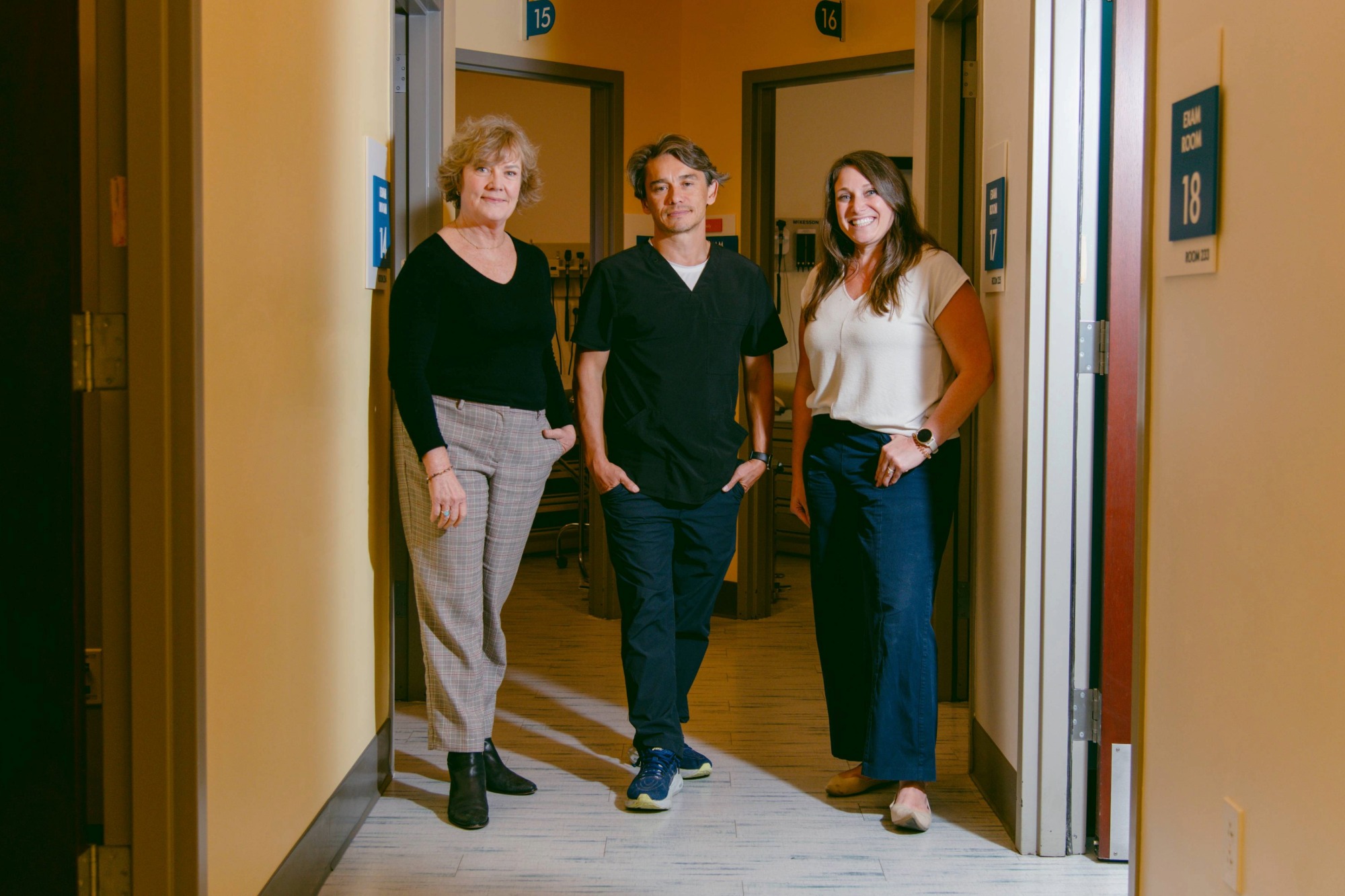In some cases, health plans may need to encourage additional providers to become waiver-trained. Waiver-trained providers may also benefit from mentorship and other support programs. Health plans should also continuously educate the provider network — both waiver-trained and other providers and care team members — to recognize at-risk members and connect them to MAT and to safer pain management.
- Understand your network: How to ensure your network is adequate to meet the needs of members with opioid use disorder
- Improve access: How to ensure at-risk members have access to waiver-trained providers and evidence-based pain management and addiction treatment
- Offer support: How to ensure your provider network has adequate support to treat at-risk patients using MAT and safer pain management techniques
Understand Your Network
Ensuring your network is adequate to meet the needs of members with opioid use disorder is key to your opioid safety initiative. First, estimate the number and location of your members who may be at risk for opioid dependence. Second, estimate the number of waiver-trained providers needed to provide appropriate levels of access to medication-assisted treatment (MAT) for these members. We provide a workforce calculator that will help you project the number of waiver-trained physicians you will need to meet the needs of your at-risk members.

How to Do It
- Identify at-risk members / opioid hot spots; at-risk members include members who:
- Are on risky regimens
- Have emergency department (ED) events associated with opioids/overdoses
- Are experiencing prescriber changes
- Require enhanced case management
- Require referrals to addiction treatment
- Understand access to appropriate levels of care across the network, and ensure MAT is available throughout the system (ED, primary care, and hospitals).
- Identify gaps in at-risk member access to critical providers, including lack of critical providers and long wait times for referrals and appointments.

Health Plan Stories
Central California Alliance for Health
When Central California Alliance for Health (CCAH) was trying to understand the extent of the opioid crisis among its members, it built a registry to identify and track patients with or at risk for opioid use disorder (OUD).
Show More
When Central California Alliance for Health (CCAH) was trying to understand the extent of the opioid crisis among its members, it built a registry to identify and track patients with or at risk for opioid use disorder (OUD). The registry served an important role in both helping CCAH track and manage the health of its population as well as understand whether it had the workforce with the skills and training necessary to address its members’ needs. The registry enabled them to see how many members might require MAT; therefore, CCAH could identify whether it had enough waiver-trained providers actively accepting and treating OUD and chronic pain patients. Developing a strong foundational understanding of its population and network of providers led CCAH to undertake subsequent initiatives focused on building its network’s capacity to meet member needs.

Tools
Workforce Projection Calculator
Download the Waiver-Trained Workforce Projection Calculator (ZIP), also available below. Use it to calculate how many physicians who are waivered to prescribe buprenorphine would be needed in your network to meet demand.
Sample Topics for Waiver Prescriber Mentor Meetings
Several health plans have created formal mentoring programs in which they pair newly trained providers with experienced providers who are able to answer questions and offer advice and coaching. Some health plans have also established mentor groups that meet regularly and discuss a range of topics related to opioid safety and pain management.
The list below includes suggested topics and related subtopics for such mentor meetings. This list is not exhaustive and should be tailored to the specific challenges the mentee is facing.
Download this tool: Sample Topics for Waiver Prescriber Mentor Meetings (PDF).

Resources
- California County Fact Sheets: These fact sheets from the Urban Institute describe the need for opioid treatment services in every California county.
Improve Access
Health plans should consider various strategies to address gaps in member access to waiver-trained providers and evidence-based pain management and addiction treatment. These strategies may include contracting with providers, including specialists, to fill gaps in the existing network; supporting providers’ completion of waiver training; and providing incentives for waiver-trained providers to see at-risk members. In this section we include tools and resources to connect providers with experts in substance use evaluation and management.

How to Do It
- Contract with necessary providers to fill gaps (e.g., pain specialists aligned with Centers for Disease Control and Prevention guidelines, providers who take a holistic approach to pain management).
- Increase the number of waiver providers in your network and increase willingness of waiver providers to see patients.
- Provide incentives for necessary providers to see patients.

Health Plan Stories
Alameda County Health Care Services Agency
The Alameda County Health Care Services Agency contracts with the Alameda Health System and eight Federally Qualified Health Centers to provide care for approximately 220,000 un- and underinsured people living in Alameda County.
Show More
The Alameda County Health Care Services Agency (HCSA) contracts with the Alameda Health System and eight Federally Qualified Health Centers (FQHCs) to provide care for approximately 220,000 un- and underinsured people living in Alameda County. In 2014, HCSA recognized that its contracts with providers could be an important lever to progressively increase the number of prescribers with buprenorphine waivers. HCSA started by tying funding to the requirement that every site have at least two waivered prescribers. By the end of 2015, approximately 60 physicians were waivered across the contracted provider sites.
After meeting this goal, HCSA required that providers maintain their numbers of waivered prescribers and demonstrate that each was prescribing buprenorphine to at least 5 patients. In 2017, the requirement grew to 10 patients receiving buprenorphine, and the sites had to accept referrals from the ED-Bridge program. Building on its success to date, the current contract requires providers to show they have a plan for safe harbor for anyone on chronic or high-dose opioids.
Central California Alliance for Health
Central California Alliance for Health offers financial incentives for providers to complete buprenorphine waiver trainings.
Show More
Central California Alliance for Health (CCAH) offers financial incentives for providers to complete buprenorphine waiver trainings. Newly trained providers are encouraged to participate in mentor meetings with experienced prescribers to get help with common questions as they begin treating patients with chronic pain and opioid use disorder.
CCAH also supports and participates in the SafeRx Santa Cruz and Prescribe Safe Monterey MAT Advisory Group. The advisory group is a peer support and resource group of physicians, advanced practice clinicians, and behavioral health providers focused on improving recovery capacity and quality for those with opioid use disorder. It meets periodically in person and also pairs local mentors with providers who have, or are interested in obtaining, a buprenorphine waiver. It also offers a Google Group for case discussions and Q&As, and a Google Drive folder with training and prescribing resources.
Inland Empire Health Plan
Inland Empire Health Plan is developing a combination of behavioral health integration and MAT pilots.
Show More
Inland Empire Health Plan (IEHP) is developing a combination of behavioral health integration (BHI) and MAT pilots. IEHP will assist selected network primary care provider organizations in the development, implementation, and integration of MAT and behavioral health services into their practices.
Both BHI and MAT are evidence-based practices. During this pilot, there will be nine physicians newly providing medication-assisted treatment to approximately 500 IEHP members with opioid use disorder. There will be eight new behavioral health clinicians providing treatment to approximately 1,500 IEHP members with behavioral health conditions. A year after the grant ends, the number of IEHP members receiving medication-assisted treatment is expected to double to 1,000. The number receiving behavioral health services is expected to increase 70% to more than 2,500. Both the MAT and BHI pilots will improve health equity by providing care to populations that have been historically stigmatized and have suffered worse health outcomes. In addition to access to treatment, one of the pilot’s primary goals is to decrease bias and stigma held by health care team staff.
L.A. Care Health Plan
L.A. Care offers provider training in substance use disorders and supports buprenorphine trainings, allowing physicians to obtain waivers to prescribe buprenorphine in primary care and other settings.
Workit Health
Workit Health is one of many new MAT telehealth providers active in California.
Show More
Workit Health is one of many new MAT telehealth providers active in California. It was created by Robin McIntosh and Lisa McLaughlin, two women in long-term addiction recovery, to break down barriers to effective, evidence-based care. Patients start buprenorphine treatment at a onetime in-person meeting at a centralized office location (currently, in Michigan and California). Patients then continue care through Workit Health’s online dashboard, where they attend video clinician visits, video drug tests, online recovery meetings, and a personalized curriculum of addiction courses. A recovery coach is available for 24/7 messaging, sending motivational messages as well as appointment reminders.
Commercial and state-funded health plans contract with Workit Health to expand MAT access for their members. In California, Workit Health offers free care to uninsured and underinsured patients, supported by California’s hub-and-spoke program. The flexibility of telehealth allows Workit to take care of patients from distant or rural areas without the demands of continual in-person follow-up visits.
In Michigan, Workit Health contracts with Priority Health, a commercial insurance plan, through a hybrid claims-based and bundled billing model, demonstrating savings on inpatient treatment costs, emergency room visits, and high opioid use. Retention rates for those in the program average around 90%, which is unheard-of for many other types of addiction treatment.
Other telehealth providers active in California and contracting with health plans include Aegis, Bicycle Health, Bright Heart Health, and Groups.

Tools
- Addiction Treatment Starts Here: Primary Care: Learning collaborative and technical assistance for community clinics learning to integrate MAT.
- MAT in County Criminal Justice Settings: Learning collaborative and technical assistance for jails to integrate MAT.
- Project SHOUT (Supporting Hospital Opioid Use Treatment): Guidelines, resources, and tools to support integration of buprenorphine and methadone treatment in hospital inpatient and surgical settings.
- UCSF Warmline: Free provider-to-provider consultation by addiction specialists, 6 AM–5 PM (PT) at 855.300.3595. Includes expertise on HIV and hepatitis prevention and treatment.

Resources
- Association for Community Affiliated Plans: Strategies to Increase MAT Prescribing
- P. Todd Korthuis et al.: “Primary Care–Based Models for the Treatment of Opioid Use Disorder“
- SAMHSA: Behavioral Health Treatment Services Locator
- University of New Mexico, UC Davis, and Weitzman Institute: Project ECHO
Offer Support
Prescribers, including both newly trained and experienced waivered providers, will need additional support to ensure they are comfortable with best practices in pain management and medication-assisted treatment (MAT). Health plans can support their provider networks by developing a support system with mentors and experienced pain management specialists to help newly trained waivered providers. Health plans can also disseminate the latest pain management research and techniques via academic detailing and training. In this section we provide suggested topics for mentor meetings and links to supportive programs and resources for providers.

How to Do It
- Develop support system (e.g., mentors and trainings) for waivered providers to encourage prescribing at all points in the health care system (primary care, mental health, hospitals, emergency departments, residential treatment, etc.).
- Create opioid safety curriculum/training program for provider network and provide incentives for participation, with the curriculum including:
- Prescribing guidelines for pain management, including when and how to taper safely to lower doses; involuntary tapers and tapering unstable patients should be avoided as they may cause harm
- Overview of medication-assisted treatment
- Guidelines for co-prescribing naloxone
- Nonpharmacologic (family-centered) neonatal abstinence syndrome treatment
- Conduct academic detailing for outlier prescribers.
- Connect providers to specialists through telehealth.

Health Plan Stories
Blue Shield of California
Blue Shield of California provides quarterly reports based on pharmacy claims data to individual opioid prescribers with patients that meet criteria for high-risk use, including total opioid dose of more than 100 morphine milligram equivalents (MME) per day, opioid prescriptions by four or more prescribers or filled at four or more pharmacies within four months, or a prescription profile indicative of a “holy trinity” regimen (those that contain an opioid plus a benzodiazepine plus a sedative hypnotic, muscle relaxant, or stimulant).
Show More
Blue Shield of California provides quarterly reports based on pharmacy claims data to individual opioid prescribers with patients that meet criteria for high-risk use, including total opioid dose of more than 100 morphine milligram equivalents (MME) per day, opioid prescriptions by four or more prescribers or filled at four or more pharmacies within four months, or a prescription profile indicative of a “holy trinity” regimen (those that contain an opioid plus a benzodiazepine plus a sedative hypnotic, muscle relaxant, or stimulant). The patient-specific data are intended to alert providers to patients who are at risk for accidental overdose and to motivate providers to make changes in their patients’ care plans. Since launching these reports, prescribers have also requested that Blue Shield share data on patients at lower doses of opioids. Reporting on both ends of the dosing spectrum has been helpful to stratify patients to the right care plan.
HealthNet
HealthNet, like several other health plans, supports the cost of clinic participation in the UC Davis Project ECHO TeleMonitoring Program.
Show More
HealthNet, like several other health plans, supports the cost of clinic participation in the UC Davis Project ECHO TeleMonitoring Program. Participants in the program have access to weekly live video sessions with a pain specialist team and evidence-based training from a multidisciplinary team on all aspects of pain management. HealthNet has a second ECHO program that targets pain management and MAT through the Weitzman Institute.
Kaiser Permanente Southern California
Kaiser Permanente Southern California raised awareness among providers about the risks to patients when converting from short-term to long-term opioid use.
Show More
Kaiser Permanente Southern California (KPSC) raised awareness among providers about the risks to patients when converting from short-term to long-term opioid use. KPSC changed the default setting in its electronic health record (EHR) to support lower doses of prescriptions for acute pain. KPSC developed EHR decision support that asked prescribers to reconsider their prescriptions; the alerts were extremely effective and led to immediate drops in specific opioid prescribing.
KPSC also invested heavily in reeducation efforts to counter decades-old beliefs that led to liberal prescribing habits. Clinical pharmacists and physicians provided high-volume prescribers with academic detailing — brief in-person educational sessions focused on evidence and the need for changing practice. Get more information about academic detailing.
Clinical champions held educational sessions at medical centers and department meetings, and KPSC required all clinicians at the time to attend an educational program developed by the University of California, San Diego. All new physicians and residents were required to complete a three-hour online continuing medical education session within their first year. KPSC has also continued frequent communications to clinicians to reinforce messages about appropriate opioid use.
Partnership HealthPlan of California
PHC recognized that there was a large problem the organization needed to address: Its network included the counties with the highest high-dose prescribing rates in California.
Show More
PHC recognized that there was a large problem the organization needed to address: Its network included the counties with the highest high-dose prescribing rates in California. In 2014, at the launch of its Managing Pain Safely program, small studies showed that, with enough support, patients on high-dose opioids could safely taper to lower doses and find improved pain management and improved function. These studies were all in controlled settings, where the patients received substantial wraparound behavioral health support services.
PHC leaders wanted to respond to the public health emergency — as opioid overdose deaths were also highest in their counties — while avoiding unintended consequences of tapering patients too quickly or too aggressively (such as the risk of pushing patients to illicit drug use and potentially even increasing overdose deaths). A 2017 Department of Veterans Affairs study showed rapid tapers led to increased suicidal ideation and increased use of mental health crisis services.
PHC invited Andrea Rubinstein, MD, a local pain medicine expert from Kaiser Permanente, to give presentations at several provider convenings, and heavily promoted her educational lectures — “The Art and (very little) Science of Tapering Opioid Medications” and “Rational and Irrational Use of Opioids” — to its entire provider network.
PHC attributes its success — an 87% drop in members on high-dose opioids — partly to the organization’s efforts to educate its provider network on the value of patient-centered tapers, with careful assessment for each patient to ensure the benefits of tapering exceeded the risks (17% of patients were too medically or psychiatrically unstable to taper). PHC created a Tapering Toolkit (PDF), which covered some of the key lessons in Rubinstein’s approach:
- The goal of tapering is to make life better — for the patient. Not for the doctor, not for the health system, and not with an arbitrary goal. Many patients are on unnecessarily high doses. Dose reduction reduces risk and improves the quality of life while commonly having little effect on their levels of pain, or at times reducing hyperalgesia.
- Look at the whole picture — not just dose level. Understand the impact of the opioid regimen on mental health, medical conditions (such as sleep apnea, bone density), pain, and function. Looking at the real risks and harms of opioids helps win patients over to the benefit of tapering — for them.
- Tapering must be customized to succeed. Tapering plans never go as expected. Adapt as you go.
- A few patients are too unstable to be tapered. Don’t taper if the patient will get worse. Stop the taper and stabilize if the patient’s function is worsening instead of improving. But most of those at very high doses can tolerate a degree of tapering to safer levels.
- Don’t aim to taper to zero. Most patients on high-dose opioids, when on them long enough, can never tolerate total opioid cessation — for the same reason that overdose risk is high for patients with opioid use disorder who are made to be abstinent. Tapering to a lower, safer dose, or tapering to buprenorphine (which has a much safer profile), should be considered a success.
San Francisco Department of Public Health
The San Francisco Department of Public Health cut opioid-related emergency visits by training prescribers to give naloxone prescriptions to all patients on daily opioids.
Show More
The San Francisco Department of Public Health (SFDPH) cut opioid-related emergency visits by training prescribers to give naloxone prescriptions to all patients on daily opioids. In addition, it leads a statewide training program on academic detailing — an interactive educational outreach method to engage physicians around evidence-based information to improve patient care. SFDPH informed prescribers of the benefits of co-prescribing naloxone to patients on daily opioids and developed toolkits and training materials to support safer prescribing practices. It developed a Guide for Primary Care Providers (PDF) and led a webinar reviewing the data supporting academic detailing and describing practical approaches to detailing.
University of Southern California
A researcher from the University of Southern California conducted an experiment with providers in San Diego.
Show More
A researcher from the University of Southern California conducted an experiment with providers in San Diego. Half of the providers received a letter stating “This is a courtesy communication to inform you that your patient (name, date of birth) died on (date). Prescription drug overdose was either the primary cause or contributed to the death.” The letter included information on the risks of high-dose opioids and provided references to websites with evidence-based materials. The research team found that compared to providers who did not receive the letter, prescriptions for opioids decreased significantly, and those providers were less likely to start new patients on opioids.

Tools
Emerging Treatment Options for Neonatal Abstinence Syndrome
Download this infographic: Emerging Treatment Options for Neonatal Abstinence Syndrome (PDF).
Other Tools
- American Society of Addiction Medicine: The ASAM National Practice Guideline for the Use of Medications in the Treatment of Addiction Involving Opioid Use (PDF)
- Centers for Disease Control and Prevention
- County of Plumas: Primary Care Guidelines Flowchart
- Kaiser Permanente: Patients on Chronic Opioid Therapy for Chronic Non-Cancer Pain Safety Guideline (PDF)
- Mentorship and conference scholarship resources: Medical Education and Research Foundation for the Treatment of Addiction
- Prescribe to Prevent
- Providers Clinical Support System
- San Francisco Department of Public Health: Naloxone for Opioid Safety: Providers Guide (PDF) and Naloxone for Opioid Safety: Patient and Caregiver Guide (PDF).
- San Francisco Health Plan: FAQ Guide for the 7-Day Limit on Initial Opioid Rxs (PDF)
- UCSF: Warmline (855.300.3595) and Clinician Consultation Center Substance Use Resources

Resources
- American Academy of Family Physicians: Pain Management and Opioid Misuse
- California Health Care Foundation
- NEJM Catalyst: “The Physicians’ Quandary with Opioids: Pain versus Addiction“
- Yale New Haven Children’s Hospital: “An Initiative to Improve the Quality of Care of Infants with Neonatal Abstinence Syndrome” (Pediatrics) and “Reconsidering the Standard Approach to Neonatal Abstinence Syndrome” (video).






